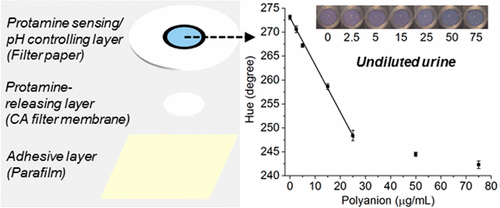当前位置:
X-MOL 学术
›
Anal. Chem.
›
论文详情
Our official English website, www.x-mol.net, welcomes your
feedback! (Note: you will need to create a separate account there.)
Inkjet-Printed Paper-Based Colorimetric Polyion Sensor Using a Smartphone as a Detector
Analytical Chemistry ( IF 6.7 ) Pub Date : 2017-11-09 00:00:00 , DOI: 10.1021/acs.analchem.7b03352 Xuewei Wang 1 , Mollie Mahoney 1 , Mark E. Meyerhoff 1
Analytical Chemistry ( IF 6.7 ) Pub Date : 2017-11-09 00:00:00 , DOI: 10.1021/acs.analchem.7b03352 Xuewei Wang 1 , Mollie Mahoney 1 , Mark E. Meyerhoff 1
Affiliation

|
The first paper-based polyion-sensitive optodes are reported. Dinonylnaphthalene sulfonic acid (a cation exchanger) and chromoionophore I (a lipophilic optical pH indicator) are printed on filter paper in the absence of any plasticizer and/or additional hydrophobic polymeric phase. The resulting optodes exhibit sensitive colorimetric response to polycations such as protamine but not to small inorganic cations because only polycations are able to form cooperative ion pairs with dinonylnaphthalenesulfonate adsorbed to the cellulose paper. The color change of the optode is recorded via an iPhone camera and analyzed by an iPhone App. The protamine-sensing optode platform is used to indirectly detect protease activity (trypsin) based on proteolytic digestion of protamine, and polyanions (pentosan polysulfate and heparin) based on the strong binding reaction of polyanions with protamine. The indirect sensing system is further simplified on a multilayer membrane device that consists of an optode paper site modified with buffer to prevent optode dependence on sample pH, and an underlying cellulose acetate filter membrane coated with protamine to eliminate addition of the indicator polycation into the sample. The detection of pentosan polysulfate concentrations in an undiluted urine sample is successfully demonstrated via this approach. Lastly, it is shown that plasticizer-free polyanion-sensitive optodes based on an adsorbed layer of quaternary ammonium type anion exchanger and a phenolic azo type proton chromoionophore can also be fabricated directly on cellulose paper strips.
中文翻译:

使用智能手机作为检测器的喷墨打印纸基比色聚离子传感器
报道了第一批基于纸张的聚离子敏感光电二极管。在不存在任何增塑剂和/或其他疏水性聚合物相的情况下,将二壬基萘磺酸(阳离子交换剂)和生色团I(亲脂性光学pH指示剂)印刷在滤纸上。由于只有聚阳离子才能与吸附在纤维素纸上的二壬基萘磺酸盐形成协同离子对,所以所得的光电二极管对诸如鱼精蛋白之类的聚阳离子表现出敏感的色度响应,而对小的无机阳离子则没有响应。光电二极管的颜色变化是通过iPhone相机记录的,并由iPhone App分析。基于鱼精蛋白的蛋白水解消化,鱼精蛋白感测optode平台可用于间接检测蛋白酶活性(胰蛋白酶),和聚阴离子(戊糖多硫酸盐和肝素)是基于聚阴离子与鱼精蛋白的强结合反应。在多层膜装置上进一步简化了间接传感系统,该装置包括用缓冲液修饰的光电极纸位,以防止光电极对样品pH的依赖性;底层醋酸纤维素滤膜上涂有鱼精蛋白,从而消除了将指示剂聚阳离子添加到样品中。通过这种方法成功地证明了未稀释尿液样品中戊聚糖多硫酸盐浓度的检测。最后,显示了基于季铵型阴离子交换剂和酚类偶氮型质子发色团的吸附层的不含增塑剂的对阴离子敏感的光电二极管也可以直接在纤维素纸条上制备。在多层膜装置上进一步简化了间接传感系统,该装置包括用缓冲液修饰的光电极纸位,以防止光电极对样品pH的依赖性;底层醋酸纤维素滤膜上涂有鱼精蛋白,从而消除了将指示剂聚阳离子添加到样品中。通过这种方法成功地证明了未稀释尿液样品中戊聚糖多硫酸盐浓度的检测。最后,显示了基于季铵型阴离子交换剂和酚类偶氮型质子发色团的吸附层的不含增塑剂的聚阴离子敏感光电二极管也可以直接在纤维素纸条上制备。在多层膜设备上进一步简化了间接传感系统,该设备包括用缓冲液修饰的光电极纸位,以防止光电极对样品pH的依赖性;底层的醋酸纤维素滤膜上涂有鱼精蛋白,以消除将指示剂聚阳离子添加到样品中。通过这种方法成功地证明了未稀释尿液样品中戊聚糖多硫酸盐浓度的检测。最后,显示了基于季铵型阴离子交换剂和酚类偶氮型质子发色团的吸附层的不含增塑剂的对阴离子敏感的光电二极管也可以直接在纤维素纸条上制备。
更新日期:2017-11-09
中文翻译:

使用智能手机作为检测器的喷墨打印纸基比色聚离子传感器
报道了第一批基于纸张的聚离子敏感光电二极管。在不存在任何增塑剂和/或其他疏水性聚合物相的情况下,将二壬基萘磺酸(阳离子交换剂)和生色团I(亲脂性光学pH指示剂)印刷在滤纸上。由于只有聚阳离子才能与吸附在纤维素纸上的二壬基萘磺酸盐形成协同离子对,所以所得的光电二极管对诸如鱼精蛋白之类的聚阳离子表现出敏感的色度响应,而对小的无机阳离子则没有响应。光电二极管的颜色变化是通过iPhone相机记录的,并由iPhone App分析。基于鱼精蛋白的蛋白水解消化,鱼精蛋白感测optode平台可用于间接检测蛋白酶活性(胰蛋白酶),和聚阴离子(戊糖多硫酸盐和肝素)是基于聚阴离子与鱼精蛋白的强结合反应。在多层膜装置上进一步简化了间接传感系统,该装置包括用缓冲液修饰的光电极纸位,以防止光电极对样品pH的依赖性;底层醋酸纤维素滤膜上涂有鱼精蛋白,从而消除了将指示剂聚阳离子添加到样品中。通过这种方法成功地证明了未稀释尿液样品中戊聚糖多硫酸盐浓度的检测。最后,显示了基于季铵型阴离子交换剂和酚类偶氮型质子发色团的吸附层的不含增塑剂的对阴离子敏感的光电二极管也可以直接在纤维素纸条上制备。在多层膜装置上进一步简化了间接传感系统,该装置包括用缓冲液修饰的光电极纸位,以防止光电极对样品pH的依赖性;底层醋酸纤维素滤膜上涂有鱼精蛋白,从而消除了将指示剂聚阳离子添加到样品中。通过这种方法成功地证明了未稀释尿液样品中戊聚糖多硫酸盐浓度的检测。最后,显示了基于季铵型阴离子交换剂和酚类偶氮型质子发色团的吸附层的不含增塑剂的聚阴离子敏感光电二极管也可以直接在纤维素纸条上制备。在多层膜设备上进一步简化了间接传感系统,该设备包括用缓冲液修饰的光电极纸位,以防止光电极对样品pH的依赖性;底层的醋酸纤维素滤膜上涂有鱼精蛋白,以消除将指示剂聚阳离子添加到样品中。通过这种方法成功地证明了未稀释尿液样品中戊聚糖多硫酸盐浓度的检测。最后,显示了基于季铵型阴离子交换剂和酚类偶氮型质子发色团的吸附层的不含增塑剂的对阴离子敏感的光电二极管也可以直接在纤维素纸条上制备。











































 京公网安备 11010802027423号
京公网安备 11010802027423号